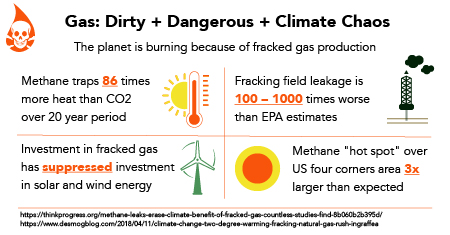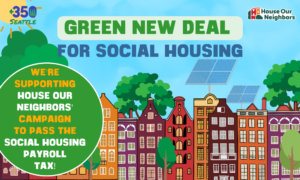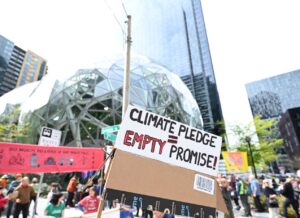If you believed everything you read, you could be forgiven for thinking that gas is a key solution to the climate crisis. Last year, The Seattle Times published an op-ed titled The Power Of Natural Gas in the War On Carbon Emissions, in which Executive Director of the NW Gas Association, Dan Kirshner, extolled the low-carbon virtues of gas — and in doing so revealed himself as nothing but a cheap con man.
Yes, gas may produce less carbon dioxide than coal or oil when burned, but that’s only part of the story.

Infographic by Manya
Gas is essentially made up of methane, a devastatingly powerful greenhouse gas that is 86 times more potent in its warming potential than carbon dioxide over a 20 year period. This is an important fact, one that means that gas is only better than coal, from a climate perspective, if leakage rates are less than 3% from the overall extraction, transportation and burning processes.
Unfortunately, very few outside of the gas industry itself believe that this is being achieved.
Currently about two-thirds of the gas produced in the US comes from fracking. Even if we put aside the laundry list of other issues related to fracking — from air and water pollution to earthquakes to the destruction of important wildlife habitat to higher rates of respiratory illness and cancer at extraction sites to the fact that gas leaks have resulted in major explosions in Seattle, Bellingham, Kansas and California, as well as last month’s major Massachusetts explosions — we know that fracking is an extraction method that leaks an awful lot of methane. Preliminary results from a field study in Utah showed that 9% of the methane produced by fracking escapes into the atmosphere. And that’s just at the point of extraction. Methane escapes into the atmosphere at every stage of gas production, including from aging residential gas pipelines in major cities. A recent survey found that the City of Boston had at least 3,332 separate methane leaks; Washington D.C. had even more.

Credit: AP Photo/Eric Gay, File
The facts about gas leakage help explain why the rate of increasing atmospheric concentrations of methane has increased tenfold since 2007. And it also helps shine a light on just how dangerous the gas industry’s lies are.
There is also significant evidence that the boom in fracking has played a major role in suppressing the development of renewable energy, as cheap gas has flooded the market, competing against and pushing out clean energy sources like solar and wind.
In WA, too, we are under attack from the gas industry’s pollution and lies. Not only are major newspapers like The Seattle Times willing to give gas executives a platform to spread their misinformation, but some of our best-known politicians are failing to take a stance against the expansion of the gas industry. Governor Inslee has failed to oppose either the Kalama methanol refinery or the Tacoma LNG facility, and Maria Cantwell proposed a bill last year that contained significant giveaways to the gas industry.
This complicity from our politicians and mainstream media is happening at a time when the gas industry poses perhaps the most significant threat to WA’s ability to achieve its climate goals.
Take the North Seattle Lateral pipeline, a pipeline that Puget Sound Energy is currently “upgrading” in south Snohomish County. After the upgrade is complete, the pipeline will have a 63% increased carrying capacity and, according to the think-tank Sightline Institute, will be contributing a whopping additional three million metric tons of greenhouse gas pollution a year (that’s almost the same as the entire city of Seattle) and will have increased WA’s greenhouse gas pollution by 3%.
Oh, and the North Seattle Lateral upgrade is designed to keep the pipeline operational for at least another 60 years, meaning that it will have locked in fossil fuel dependency in our region for generations.
We need to understand that this is what expansion of the gas industry in WA looks like. Gas expansion won’t always come in the shape of huge new pipelines or mega facilities like the one in Tacoma. Sometimes that expansion will appear more incrementally. Upgrading a pipeline here, adding a few more miles of pipe there. Bit by bit, the gas industry will expand stealthily, in ways that fly under the radar.
But the end result will be the same: a vast increase in greenhouse gas pollution.
Fortunately, there are tools are our disposal to combat this sort of growth from the gas industry. Portland, Aberdeen, Whatcom County, and Baltimore are just a few of communities that have successfully updated their land use zoning codes to prohibit the dangerous expansion of the fossil fuel industry. And that’s a tactic we should pay attention to here in King County.
And as we are doing so, let’s also remember that a gas executive extolling the environmental virtues of gas is about as trustworthy as a McDonald’s CEO praising the health benefits of hamburgers.
Want to get the latest as we take on the gas industry? Sign up here!









